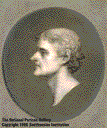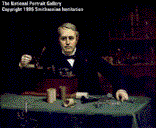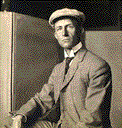

Inventors
Recording and collecting the work of inventors has long been a mission of the Smithsonian.The Lemelson Center of the National Museum of American History documents, interprets, and disseminates information about invention and innovation, and fosters an appreciation for the central role invention and innovation play in the history of the United States. The National Air & Space Museum explores the invention, history, science, and technology of aviation and space flight. The Anacostia Museum has a special exhibit: The Real McCoy, African-American Invention and Innovation, 1619-1930 and the Remembering Gallery's exhibit: American Inventors and Inventions. Here we examine a handful of famous Amercan inventors, some like Benjamin Franklin, who are well known for their creations, others such as Thomas Jefferson, who are better known for other contributions.
 Joseph
Siffrèd Duplessis (1725-1802)
Joseph
Siffrèd Duplessis (1725-1802)
Oil on canvas, circa 1785, NPG.87.43
National Portrait Gallery,
Smithsonian Institution, Washington, D.C.
Gift of the Morris and Gwendolyn Cafritz Foundation
The adage "Early to bed and early to rise, makes a man healthy, wealthy, and wise" certainly worked for Benjamin Franklin. In addition to being a printer, statesman, scientist, philosopher, and inventor, Franklin has become a widely respected symbol of American ingenuity and industry. While some of Franklin's inventions are now little known, many, such as the lightning rod, bifocal glasses, and his common-sense aphorisms, are still in use today.
Franklin's first career was in printing. The American Museum of Natural History owns the printing press on which Franklin worked in the 1720s. Franklin was also America's first postmaster general. British authorities named him postmaster of Philadelphia in 1737, and later promoted him to joint postmaster general for the Royal Post. During his tenure, Franklin cut colonial mail-delivery times in half. But he was dismissed in 1774 for "revolutionary activities." (Could it have been because post riders were spreading information about the colonial uprising?) A year later, the new Continental Congress restored him to the position of postmaster general; thereafter, Franklin returned his salary to Congress for the relief of wounded soldiers.
Franklin conducted groundbreaking research on static electricity. His theory that electricity is a fluid may have been misguided, but other ideas were on the right track: for example, he proposed that all matter was made up of electric particles, and he suspected that lightning is electric in nature.
Like Thomas Jefferson and many other founding fathers, Franklin was also an educational reformer, and his 1749 publication of Proposals Relating to the Education of Youth in Pensilvania paved the way to the foundation of the University of Pennsylvania.
 Charles
Bird King (1785-1862) after Gilbert Stuart (1755-1828)
Charles
Bird King (1785-1862) after Gilbert Stuart (1755-1828)
Oil on panel, 1836, NPG.92.110
National Portrait Gallery,
Smithsonian Institution, Washington, D.C.
Thomas Jefferson was a true Renaissance man: an accomplished politician, philosopher, educational reformer, scientist, scholar, attorney, and horticulturist, as well as the third President of the United States. He is perhaps most famous for his role as one of America's founding fathers, but he was also an inventor. In the course of his work, he invented several practical objects, among them the swivel chair and a copying device.
He loved farming, and at his plantation, Monticello, he developed many new agricultural implements and techniques. Among other crops, he encouraged the development of grape producation and wine-making in America. One of his less successful creations was a wooden moldboard, or plow, that could be easily manufactured. Prior to that, farmers had to make their own plows by hand. The idea never caught on, however, as metal plows were already beginning to replace wooden ones.
 Jean-Antoine
Houdon (1741-1828)
Jean-Antoine
Houdon (1741-1828)
Bronze, cast after 1803 plaster, NPG.69.2
National Portrait Gallery,
Smithsonian Institution, Washington, D.C.
Robert Fulton began his career as a portrait painter before turning to engineering. Although we credit Fulton with the invention of the steamboat, he primarily capitalized on the inventions of others to create a successful industry. By using America's interior waterways and improving transportation, Fulton's steamboats had a powerful impact on trade, industry, and western settlement. Progress also brought new hazards. As one traveler said, "Aside from the collisions . . . which are more frequent than the explosions of their boilers, this would be the most agreeable way to travel in America."
Soon after efficient steam engines were perfected in the late eighteenth century, inventors began looking for ways to incorporate them into sailing vessels. At the same time, Americans were eager to better use the country's navigable interior waterways. Fulton's boats, introduced in 1807, provided the first commercially successful steamboat service in this country.
Always eager to speed delivery time, the Postal Service took advantage of each new method of transportation. The "Moving the Mail" exhibit at the National Postal Museum examines both the advantages and the drawbacks of using steamboats for mail delivery.
 David C. Hindman
(circa 1830-1840) after Charles Bird King (1785-1862)
David C. Hindman
(circa 1830-1840) after Charles Bird King (1785-1862)
Engraving, 1847, NPG.86.86
National Portrait Gallery,
Smithsonian Institution, Washington, D.C.
Eli Whitney's 1793 invention, the cotton gin, completely changed agriculture in the South. By automatically separating the seeds from cotton fibers, the cotton gin greatly reduced the time and labor needed to process cotton, sending production skyrocketing. However, Whitney and his partner Phineas Miller never made any money on the cotton gin, because of planters' prefrence for using cheap pirated versions of the invention, rather than paying Whitney and Miller their due. Whitney never bothered to patent his inventions after that. Later, Whitney developed the concept of mass production of interchangeable parts that formerly had only been made by hand by individual craftsmen. He first applied this technique to musket production for the government.
Prior to Whitney's invention of the cotton gin in 1793, America imported cotton; soon after the widespread use of the cotton gin, it became a major export. As the industry grew, southern planters relied increasingly on African slave labor for the backbreaking jobs of planting and harvesting. Though sharecroppers replaced slave labor after the Civil War, cotton farming remained virtually unchanged until the invention of a mechanical harvester in the 1940s.
An African American sharecropper on a typical southern cotton farm struggled to survive both hard work and widespread discrimination. Decades after the Civil War African Americans left the South in search of a better life in the northern cities.
Edward Lind
Morse (1857-1923)
Oil on canvas, 1895, NPG.71.23
National Portrait Gallery,
Smithsonian Institution, Washington, D.C.
Transfer from the National Museum of American History
Samuel F. B. Morse, like Robert Fulton, worked as a portrait painter for more than twenty years. Despite his artistic success, in the 1830s he did something that many other mechanically inclined gentlemen did in those times--he turned to invention. However, he did not entirely abandon his beloved artwork until his mid-forties. Morse hit the jackpot with his model for a magnetic telegraph. "Attention the Universe," he announced in code at his machine's first public display in 1837. Indeed, the ability to communicate instantly over long distances heralded the beginning of an information revolution. The first public telegraph office opened in 1845, in the old post office building across from the National Portrait Gallery, at F and Seventh Streets, N.W., in Washington, D.C.
Morse spent many years fighting legal disputes by both rivals and former partners. Eventually the U.S. Supreme Court awarded him the patent rights.
The first machines recorded the dots and dashes of Morse code on a roll of paper, until telegraph operators discovered that they could hear the pattern faster than it could be written. The "Information Age" exhibit at the National Museum of American History chronicles the development of a standard code, the creation of a system of telegraph wires--including the first transatlantic cable--and the development of wireless telegraphy, which led to modern-day radio.
Morse also brought the French technology of daguerreotypy to the United States, as described in the daguerreotypy exhibit at the National Museum of American Art, "Secrets of the Dark Chamber."
America's first transcontinental telegraph line put the Pony Express out of business by 1861. Although the Express provided a useful service for the eighteen months of its existence, it couldn't compete with the nearly instant communication made possible by the telegraph. The "Binding the Nation" exhibition at the National Postal Museum details the history of the Pony Express.
 Unidentified
artist, after Charles Loring Elliott (1812-1868)
Unidentified
artist, after Charles Loring Elliott (1812-1868)
Oil on canvas, not dated, L/NPG.6.77
National Portrait Gallery,
Smithsonian Institution, Washington, D.C.
On loan from the National Museum of American HIstory; gift of Elias Howe
Stockwell
and
 Edward
Harrison May (1824-1887)
Edward
Harrison May (1824-1887)
Oil on canvas, 1869, NPG.75.37
National Portrait Gallery,
Smithsonian Institution, Washington, D.C.
Gift of the Singer Company
Elias Howe was one of many who sought to invent a continuous-stitch sewing machine. Too sickly to work and support his family, Howe spent hours watching his wife sewing for a living, trying to envision a mechanism that could duplicate the action. Howe is credited with inventing the first workable design, although it was impractical and awkward to use. Furthermore, he was a terrible businessman and lost much of the money that was rightfully his. Isaac Singer, on the other hand, never came up with original designs but combined the best elements of others' work into a practical and commercially successful machine. Due in part to a clever marketing scheme, Singer came to be heralded as the king of the sewing machine, despite the fact that he was sued for patent infringement, by Howe and many others.
Howe's machine was difficult to use because the operator had to frequently re-pin the cloth vertically onto a short baster plate--a prickly task. It is not hard to see why Singer's model, with its flat working surface and continuous operation, was favored over Howe's.
John Wycliffe
Lowes Forster (1850-1938)
Oil on canvas, 1919, NPG.85.74
National Portrait Gallery,
Smithsonian Institution, Washington, D.C.
Gift of Gilbert Grosvenor Coville
"My God, it talks!" sputtered the emperor of Brazil as he watched Alexander Graham Bell demonstrate the telephone at the 1876 Centennial Exposition. For most viewers, witnessing the instant transmission of voice was an amazing and futuristic experience. However, few spectators fully realized how Bell's invention would revolutionize world communications. Most people scoffed at the idea of a telephone in every home (let alone three or four), and even Bell viewed his invention primarily as an office tool. The Smithsonian Institution owns Bell's first successful telephone.
Bell spent much of his lifetime as an educator, and in particular teaching the deaf to speak: one of his most famous students was Helen Keller. In 1880, Bell used the proceeds from his award of the Volta prize by the French government, to finance the Volta Laboratory and ten years later the American Association to Promote the Teaching of Speech to the Deaf (now known as the Alexander Graham Bell Association for the Deaf). His continual search for new methods to help students learn led to his role in the development of early recording devices. At the Volta Laboratory, workers competed with Thomas Edison to produce a commercially viable phonograph. One 1881 prototype speaks the message "I am a graphophone and my mother was a phonograph..." Apparently, Bell's engineers were comedians as well.
Like most other inventors of the time, Bell fought lengthy lawsuits over patent rights to his creations. By the end of his life Bell's name was on thirty patents, ranging from telephones to phonographs to flying machines. Bell was also the second president of the National Geographic Society, succeding his father-in-law for that position. His wife, Mabel Hubbard Bell, was the first woman to found and head a research organization: The Aerial Experiment Association, which illustrates her collaborative role with her husband on many of his projects.
 Abraham
Archibald Anderson (1847-1940)
Abraham
Archibald Anderson (1847-1940)
Oil on canvas, circa 1890, NPG.65.23
National Portrait Gallery,
Smithsonian Institution, Washington, D.C.
Transfer from the National Museum of American Art; gift of Dr. Eleanor
A. Campbell to the Smithsonian Institution, 1942
Question: How many people did it take to screw in a lightbulb in 1879? Answer: One, but there was nothing to plug it into! (light bulbs were invented in 1879, but they didn't have screw-in bases until much later). While many people associate Thomas Alva Edison with the incandescent light, they often forget about the electrical generating stations, switches, plugs, and the miles of wire that connect them. Edison's progress in these areas, and many more, helped lay the foundations for our modern world.
For instance, Edison contributed to the development of the telephone. Bell may have invented it, but Edison developed a transmitter that made communication possible over long distances. The Western Union Telegraph Company collection at the National Museum of American History has many patents on telecommunication technology invented by Edison. Edison also created the first workable phonograph. His early models played on a cylinder, while later ones used a flat disk.
 Léon
Bollée (1870-1913)
Léon
Bollée (1870-1913)
Photograph, 1909, NPG.91.101
National Portrait Gallery,
Smithsonian Institution, Washington, D.C.
History will forever regard Wilbur and Orville Wright almost as a single entity. In fact, they were two very distinct personalities. While the younger Orville was creative and impetuous, Wilbur was steady, plodding, and determined. In some relationships, such a fundamental difference might prove detrimental. In their case, however, it became a crucial ingredient for success. While Orville was a font of ideas in their joint quest for a viable motorized aircraft, Wilbur was the one with the disciplined patience needed for translating those ideas into reality.
Wilbur Wright was born in Millville, Indiana, and grew up in Dayton, Ohio. From his father, a clergyman and editor, he learned to love reading, writing, and other scholarly pursuits. From his mother he picked up a knack for devising clever mechanical toys and appliances, a talent that earned him pocket money as a teenager. He also contributed stories to his father's magazine, Religious Telescope, and to the West Side News, a small paper printed by his younger brother Orville on a press he had built himself. Later, the two brothers ran a successful bicycle shop.
Around 1896, Wilbur and Orville began to discuss the subject of flying. Of course, human flight had been dreamed of for centuries, but new knowledge about the laws of aerodynamics was placing it within reach for the inventor who could devise a stable, controllable aircraft. After studying all available material on the subject, Wilbur built a five-foot model biplane in 1899, which he flew like a kite. This led to a full-scale glider in 1900, which the brothers tested on the Outer Banks of North Carolina, near Kitty Hawk. A second glider followed two years later. Based on the experience of thousands of glider runs and experiments in a homemade wind tunnel, the brothers compiled new, more accurate data on the effects of wing design on lift, drag, and center of pressure. Using a system of rudders and wing deformation, they created a balanced aircraft that could be controlled by the pilot on all three axes of rotation. In practical terms, it was the first airplane that could safely and predictably move up or down, left or right. The only thing left to do was to add an engine.
On December 17, 1903, after waiting nearly three months for suitable weather, the Wright brothers were ready to test their first powered aircraft. To their previous design they added two propellers driven by a twelve-horsepower motor via a bicycle chain. The first flight, with Orville as pilot, traveled 120 feet in twelve seconds. Later, Wilbur extended the flight time to fifty-nine seconds before a gust of wind flipped the aircraft and rendered it inoperable. Few spectators were on hand to witness the milestone event, and the idea of powered flight was slow to catch on, even as the Wrights improved the efficiency and practicality of their design. However, after successful exhibition flights in New York, France, and elsewhere, business began to boom at the newly formed American Wright Company. Wilbur gained fame, along with his brother, as a steely, weatherbeaten flyer, but he also proved to be a savvy businessman, winning contracts from the United States government as well as from Britain, Germany, Italy, and France. However, he never witnessed the full impact of their work, as he died in May 1912 of typhoid fever. Orville, who died in 1948, at the dawn of the jet age, did survive to see the airplane revolutionize war, commerce, travel, and numerous other aspects of twentieth-century life.
The aircraft that the Wright brothers used on their pioneering flight near Kitty Hawk, North Carolina, hangs in the "Milestones of Flight" gallery at the National Air and Space Museum. Other exhibits in the "Early Flight" gallery show how they developed a successful design through aerodynamic research and experimentation. In a sense, the entire Air and Space Museum is a monument to the legacy of the Wright brothers' groundbreaking success.
LINKS
General
Benjamin Franklin
Thomas Jefferson
Robert Fulton
Eli Whitney
Samuel F. B. Morse
Elias Howe and Isaac Singer
Alexander Graham Bell
Thomas Edison
Wilbur Wright